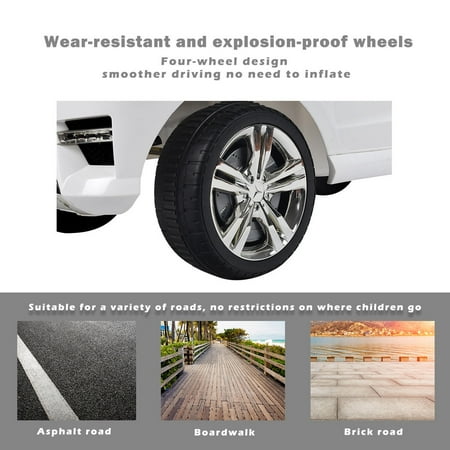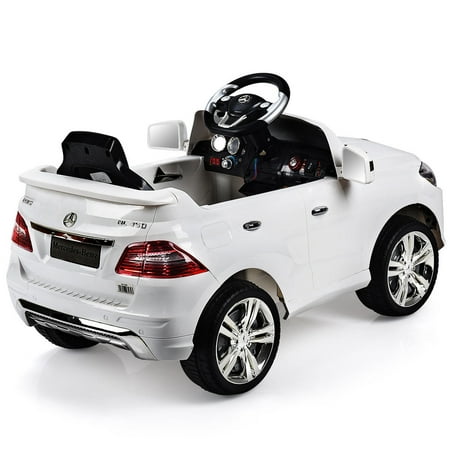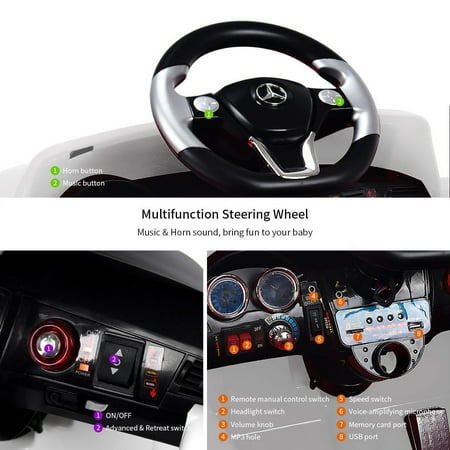Costway Mercedes Benz ML350 6V Electric Kids Ride On Car Licensed MP3 RC Remote Control
Notice: Not sold to consumers located in CaliforniaThis Is Our Fantastic And Functional BABY RIDE ON CAR For Your Lovely Children. It is Beautiful Working Lights And Doors Add To The Sense Of Being In A Real Car While The Auto Power-Off Protection System It Contains Increases Its Safety. It can not only be controlled by the remote, but also by the electrical foot pedal and steering wheel. The Comfortable Seat And MP3 Aux Provide An Enjoyable Environment For Your Babies When Playing. Do not hesitate to buy one now!FeatureNotice: Not sold to consumers located in CaliforniaSuitable For Child With Age From 37 To 72 MonthesDrives On Flat SurfacesAbility to play music and sing through an MP3 Aux, USB port, or TF port and voice-amplifying MicrophoneBattery Operated, Continuous Fun For 1 HoursWith Parental Remote ControlMP3 InputComfortable Seat With Safety Belt (The safety belt enclosed is only a toy for increasing children’s safety awareness)Foot Pedal For AccelerationWith HornMovable Wing MirrorsLED Headlights2 Mode:R/C(Remote Control) And B/0(Battery Operate) ModeSpecificationColor:Red,White,BlackMain Material:PlasticAmbient Temperature:0-40 degree centigradeSize:37.4”X23.6” X20.4”(L XW XH)Weight:about 22 Lbs;Carrying Capacity:about 44 Lbs;Speed:1.86MPHBattery:6V Closed Dry BatteryCharger:Input AC 220V 50HZ/Output DC 6V 1000Ma;Charging Period:8-12 Hours Each Time;Motor:DC 6V*2;>Package include:1 x toy car, 1 x remote










TWO MODES – 1. 2.4G Parental Remote Control Mode: You can control this car to enjoy the happiness of being together with your baby. 2. Battery Operated Mode: Your baby can operate this car by himself/herself by electric foot pedal and steering wheel to choose ideal speeds.SAFE RIDING – Comfortable seat with safety belt provides large space for your baby to sit (the safety belt enclosed is only as a substance to increase children’s safety awareness, please keep an eye to your baby when he/she is playing).FULL ENJOYMENT – When this car is fully charged, your baby can continuously play it by 90 minutes which makes sure that they can fully enjoy it. Equipped with LED headlights, MP3/USB/TF input, music, horn, volume controller, microphone function, it will make your baby’s ride more enjoyable.STYLISH LOOKING & PREMIUM QUALITY – Licensed Mercedes Benz ML350, Eye-catching appearance provides your little ones superior driving enjoyment and real fun. Made of most durable plastic material for a smooth and enjoyable ride.【This product is not for sale in California】Product Size:25″x 40″ x 21″(L x W x H), Weight Capacity: 44 lbs, Speed: 2.4-3.1 km/h, Suitable for children from 3 to 6 years old. Please kindly check the product size before purchase, as some children grow up faster. Note: Please take off the plastic axle sleeve before installing the wheel. It is normal if the plastic axle sleeve is damaged upon arrival, which is only designed for axle protection in transit.



Reviews
There are no reviews yet.